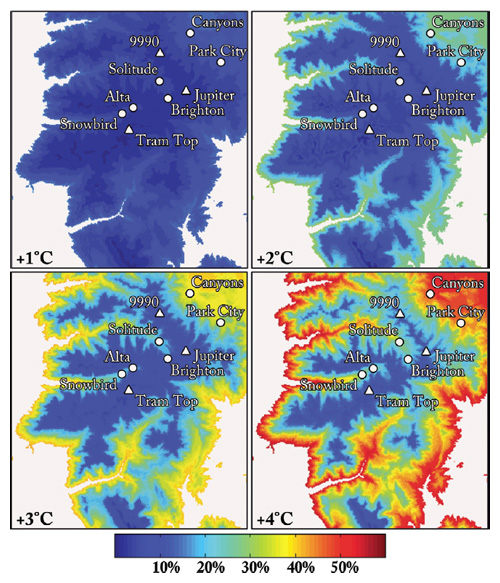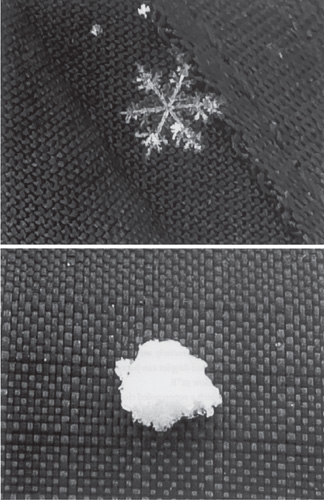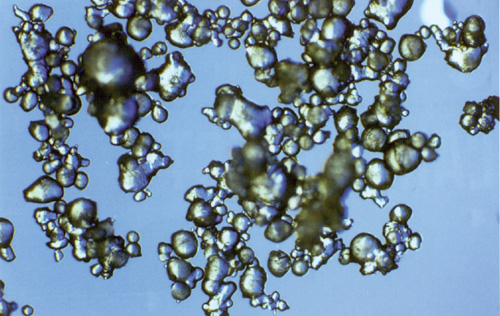
This Article From Issue
March-April 2015
Volume 103, Number 2
Page 151
DOI: 10.1511/2015.113.151
SECRETS OF THE GREATEST SNOW ON EARTH: Weather, Climate Change, and Finding Deep Powder in Utah’s Wasatch Mountains and Around the World. Jim Steenburgh. ix + 186 pp. Utah University State Press, 2014. $21.95.
Jim Steenburgh encountered plenty of snow during his childhood in upstate New York, but once he finished high school and hit the sparkling, powdery slopes of the Northwest, he never looked back. His enthusiasm for skiing led him to study atmospheric sciences. He specialized in mountain meteorology, earning a doctorate and landing his dream job in 1995 at the University of Utah, where he has been a professor ever since.

From Secrets of the Greatest Snow on Earth.
Secrets of the Greatest Snow on Earth exuberantly unites Steenburgh’s dual passions for meteorology and downhill skiing. Although he still spends most of his free time skiing, his interest in snow extends beyond its role as a necessary substrate for his favorite sport. As a scientist, he feels compelled to learn all there is to know about the stuff: what snow is composed of, how it takes so many different forms, and why the outcome of any given snowstorm can be so difficult to predict. (One key piece of information he shares: Snowflakes are not frozen raindrops—that would be sleet. Snowflakes are their own distinct type of precipitation, formed when water vapor skips the liquid phase and condenses directly into ice.) Fortunately for the reader, Steenburgh is not just an enthusiast; he is also a born teacher. As he explores he explains, and his zest for the subject is contagious.
One of the author’s aims, he says, was to investigate the claim that has been featured on Utah license plates for 30 years: “Greatest Snow on Earth.” To settle the question, he surveys the world’s major skiing regions, comparing the merits of each. Tellingly, this exploration is contained within a single chapter, titled “Beyond Utah.” Judging by the swiftness of the journey—the author bounds across both the eastern and western coastal ranges of North America, the Rockies, the Tetons, the Andes, the European Alps, New Zealand, and two islands of Japan, all in just over 20 pages—the reader may conclude that Steenburgh’s heart remains in Utah. He allows that Andermatt, Switzerland, “has one of the more reliable snow climates in Europe.” In Argentina, Las Leñas “has the best powder reputation in the Southern Hemisphere” but “still falls short of the Cottonwood Canyons in terms of quantity and consistency.” Even the northern Japanese island of Hokkaido, whose mountains receive an average snowfall of 480 inches per year, is only “perhaps [emphasis added] the strongest contender to Utah’s claim.”

From Secrets of the Greatest Snow on Earth.
The chapters that follow see the author back on the home slopes, where he resumes his informative (and informal) role as the Snow Scientist. In a chapter investigating how snowflakes are made, Steenburgh describes why every detail of the weather has its significance: “The shape, size, and composition of these snowflakes determine if you are skiing hero snow, crud, or concrete.”
He explains the five-step chemical process that transforms water vapor from the atmosphere into snow and the ways that variables such as altitude, wind speed, saturation, and even the amount of pollution in the air can act on this process to yield snowflakes with very different physical properties. Arcane terms such as graupel (a type of snow pellet) and cold smoke (snow with low water content) are demystified and given a context in which they make sense. Steenburgh looks at the production of artificial snow as well, recognizing that it fills a need but explaining in scientific terms why it’s inferior to the real thing.
Utah’s Great Salt Lake gets a short chapter all to itself—deservedly so, because this unusually shallow and salty body of water defies most of the conventions of “lake-effect” snowstorms commonly seen in the Upper Midwest. A shallow lake with no outlet, its depth and area vary considerably from year to year based on snowfall and drought conditions. The lake’s fluctuating size, as well as its long northwest-southeast shape relative to prevailing winds and two different levels of salinity (an earthen causeway cuts across the middle, limiting the flow of freshwater to the northern half of the lake), makes the Great Salt Lake effect notoriously difficult for skiers to predict.

From Secrets of the Greatest Snow on Earth.
From there, Secrets of the Greatest Snow on Earth turns to avalanches, which—like everything else involved with snow, clearly—have a great variety of causes and outcomes. Although the author wanders through a 75-year history of avalanche-control efforts before defining the nature of the hazard or explaining the North American Public Avalanche Danger Scale, the story of the Utah National Guard using a French howitzer to set off a preventive blast seems worth the detour. Steenburgh’s unflinching look at why it is most often the expert skiers, rather than novices, who fall victim to avalanches doesn’t make for cozy reading, but it may save a few lives. For those who cannot resist the lure of untracked powder, his advice on how to prepare for a possible avalanche may prove invaluable.
The penultimate chapter describes the wide variety of tools available for meteorology today and walks the reader through an elementary process for synthesizing masses of data into do-it-yourself weather predictions (focusing on snowfall, of course).

From Secrets of the Greatest Snow on Earth.
Concluding on a more somber note, however, Steenburgh addresses the unavoidable question of what winter will bring for the snow lovers of the future. After reviewing the scientific evidence on global warming, he is characteristically blunt: “More rain, less snow.” For solutions he offers only one practical idea, with a strictly local application. “Reducing the number and intensity of dust sources in southern and western Utah,” he notes, “could be a way to mitigate the effects of global warming, slow the spring snowmelt, and enable a longer ski season in a warming world.” This solution is small comfort, given the scale of the problem, and Steenburgh also recognizes the need to reduce the production of greenhouse gases globally.
When it comes to snow, the details—both small- and large-scale—do matter. If we all observed our surroundings with as much curiosity and enthusiasm as Steenburgh, the world could be a much better-tended place.
Sandra J. Ackerman is senior editor of American Scientist. Her most recent book, Hard Science, Hard Choices: Fact, Ethics, and Policies Guiding Brain Science Today, was published in 2006 by Dana Press.
American Scientist Comments and Discussion
To discuss our articles or comment on them, please share them and tag American Scientist on social media platforms. Here are links to our profiles on Twitter, Facebook, and LinkedIn.
If we re-share your post, we will moderate comments/discussion following our comments policy.